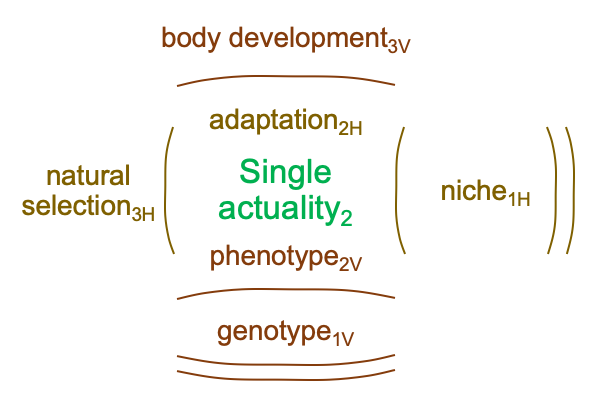0071 Each story about a change of genotype potentiating a new phenotype also is a story about an adaptation into a niche.
For the nylonase-producing bacteria, the niche is a waste pond full of industrial polymers.
For animals with backbones, the niche could be related to protection and movement.
For the fruit fly example, the niche may consist of proteins or molecules that were not previously transported. The transport protein related to p24 may be receptive to changes in an environment that is independent of the species.
For the S-receptor virus, the niche was a petri dish filled with lots of S bacteria.
0072 In all these examples, genetic changes would not have been of value if the phenotype did not exhibit an adaptive advantage. Genetic changes may have occurred. But, they would not have been remembered by later generations.
0073 What does this mean?
Phenotype2b and adaptation2b are two actualities produced by independent methods of inquiry. They inherently contradict one another. They also inherently complement.
0074 They intersect and form one actuality: descent with modification.
Here is my diagram of the intersection of adaptation2b and phenotype2b.

0075 Intersections are curious beings.
Classical Darwinism constitutes the horizontal axis. It assumes some type of inheritance, but does not know how it works.
Neo-Darwinism constitutes the vertical axis. It assumes the niche, and does not know how it works.
0076 Alone, neither classical nor neo-Darwinism can provide a full explanation of descent with modification.
Likewise, descent with modification cannot be reduced to one or the other nested form.
0077 Indeed, a miracle lies hidden within each intersection.
0078 On one hand, consider the virologists who find the right mix of R and S bacteria to observe the R-killing virus evolve to the S-killing virus. They do not know whether other mutations would have produced an S-latching virus. They can only account for the genetic changes retrospectively (that is, after the event). They could not have predicted what mutations would do the trick.
So, the genetic part is like a miracle.
0079 These scientists precisely define the niche. The resulting gene changes are what (miraculously) happen to occur.
0080 On the other hand, consider the geneticists who isolate the chromosomal changes between chordates without backbones and chordates with backbones. They may understand the DNA-altering mechanisms involved in these changes, but they cannot prospectively re-enact the niche that rewarded the phenotypes as adaptations.
So, the niche part is like a miracle.
0081 These scientists delineate the genetic changes. But, they have no idea how to reconstitute the niche. The niche is what (miraculously) happened to occur.
